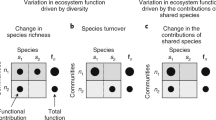Summary
Changes in species diversity are examined in relation to a multidimensional environmental gradient using Eucalyptus species in south-eastern Australia. By fitting a generalized linear model, the response of the community parameter, species diversity, is shown to be related to three environmental variables, mean annual rainfall, mean annual temperature and a relative measure of solar radiation. The effects of rainfall and temperature were both statistically significant and large, solar radiation was significant but small. However, the influence of the two major variables was not independent but interacted in a complex way that prevents adequate description of species diversity as a function of either variable alone. Possible biological explanations of the complexity are discussed in terms of limiting conditions at low temperatures, and competition between guilds of species at high temperatures and medium to high rainfall.
Similar content being viewed by others
References
Abramsky Z, Rosenzweig ML (1984) Tilman's predicted productivity-diversity relationship shown by desert rodents. Nature 309:150–151
Adomeit EM, Austin MP, Hutchinson MF, Christenson K (1984) A rainfall surface and contour map of south-eastern Australia. CSIRO Division of Water and Land Resources Tech Memo 84/1
Austin MP, Cunningham RB, Good R (1983) Altitudinal distribution of several eucalypt species in southern New South Wales. Aust J Ecol 8:63–71
Austin MP, Cunningham RB, Fleming PM (1984) New approaches to direct gradient analysis using environmental scalars and statistical curve-fitting procedures. Vegetatio 55:11–27
Baker RJ, Nelder JA (1978) The GLIM System: Release 3. royal Statistical Society, Oxford
Brown JH (1984) On the relationship between abundance and distribution of species. Amer Nat 124:255–279
Dobson AJ (1983) An introduction to statistical modelling. Chapman and Hall, London
Gill AM, Belbin L, Chippendale GM (in press) Phytogeography of Eucalyptus in Australia. Australian flora and Fauna Series, No 3, Australian Government Publishing Service, Canberra
Grime JP (1979) Plant strategies and vegetation processes. Wiley, Chichester
Helman CE (1983) Inventory analysis of southern new south wales rainforests. Unpubl M Sc Thesis, University of New England, Australia
Hutchinson MF (1984) A summary of some surface fitting and contouring programs for noisy data. CSIRO Division of Mathematics and Statistics, Consulting Report ACT 84/6
Lawton JH, (1984) Different ways of being a mouse. Nature 309:112
McCullagh P, Nelder JA (1983) Generlised linear modelling, Chapman and Hall, London
Peet RK (1978) Vegetation of the Colorado front range: patterns of species diversity. Vegetatio 37:65–78
Tilman D (1982) Resource competition and community structure. Monographs in population biology 17. Princeton University Press Princeton
Author information
Authors and Affiliations
Rights and permissions
About this article
Cite this article
Margules, C.R., Nicholls, A.O. & Austin, M.P. Diversity of Eucalyptus species predicted by a multi-variable environmental gradient. Oecologia 71, 229–232 (1987). https://doi.org/10.1007/BF00377288
Received:
Issue Date:
DOI: https://doi.org/10.1007/BF00377288




